Recently, the extravagant wedding of Anant Ambani, the youngest son of India’s richest man Mukesh Ambani, and his fiancée Radhika Merchant, which had been in the spotlight for half a year, finally came to an end!


This lavish wedding, costing 500 billion Indian rupees, began in March with a series of pre-wedding parties, yacht parties, and performances by international stars like Rihanna and Justin Bieber to build up the hype.
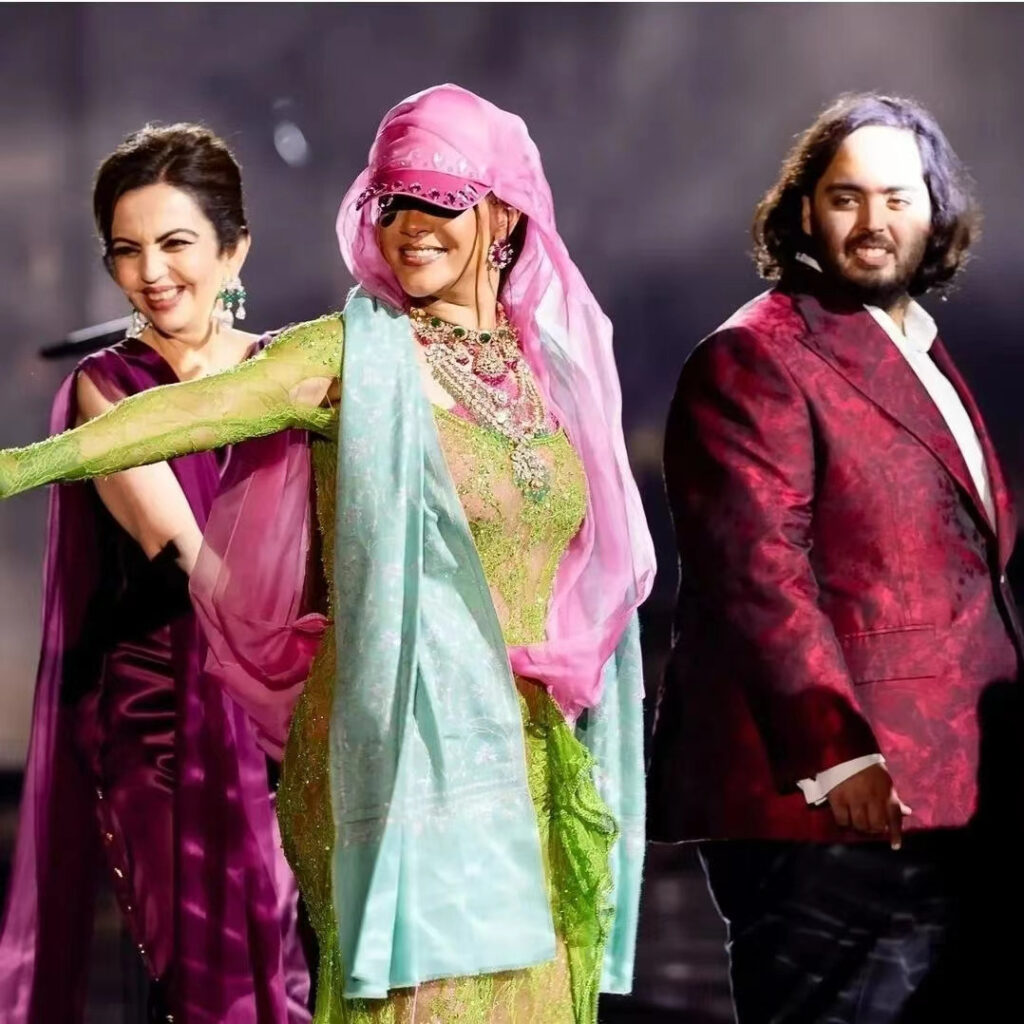


The official wedding guest list was equally impressive, including Indian Prime Minister Modi, former British Prime Minister Tony Blair and his wife, former BP CEO Bob Dudley, and Hollywood celebrities like the Kardashian sisters.
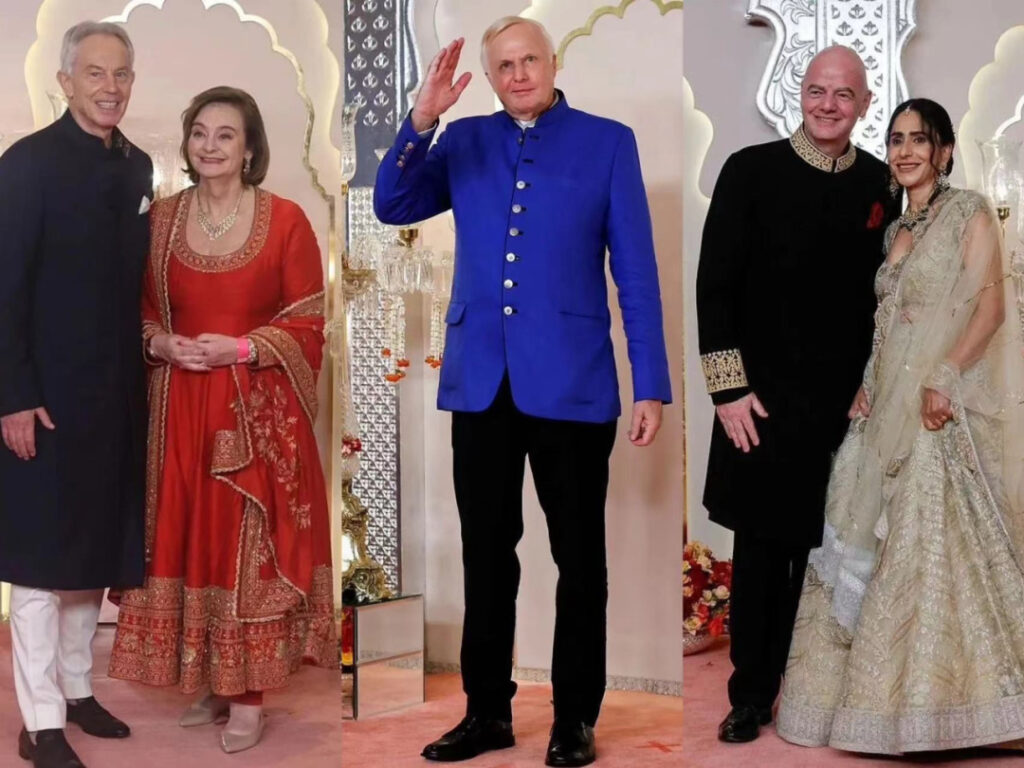
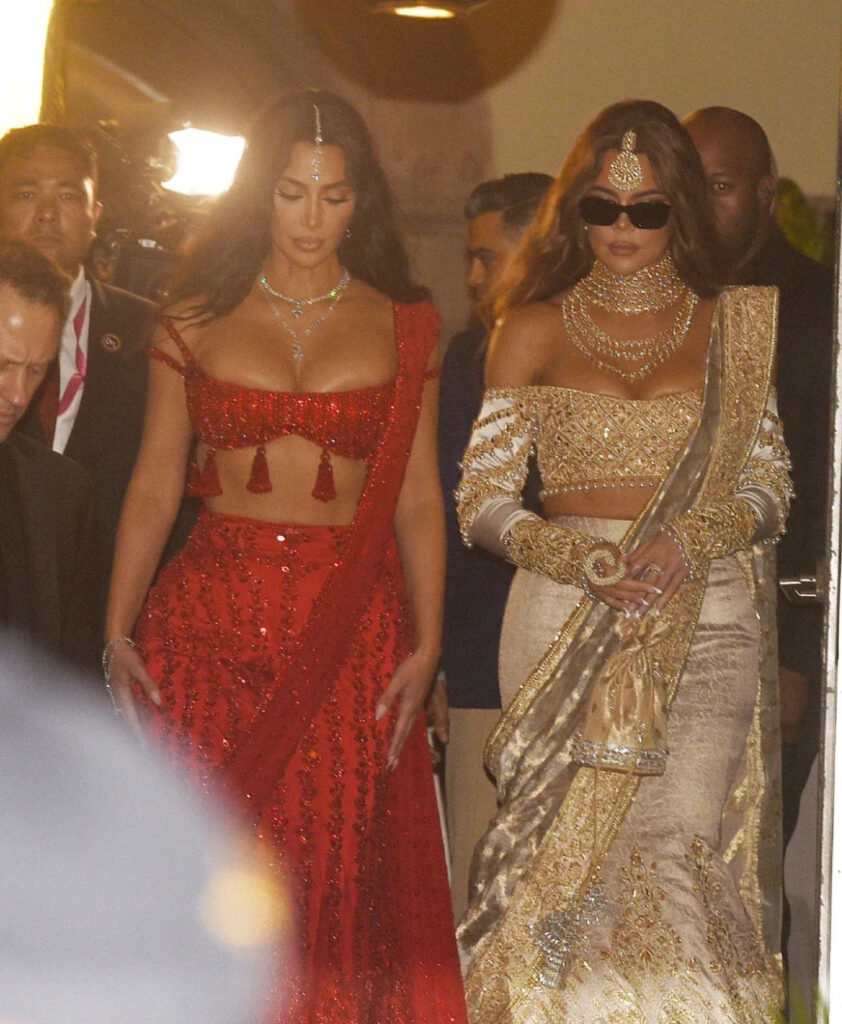


For jewelry enthusiasts, this was a feast of luxury far surpassing any high-end jewelry auction.
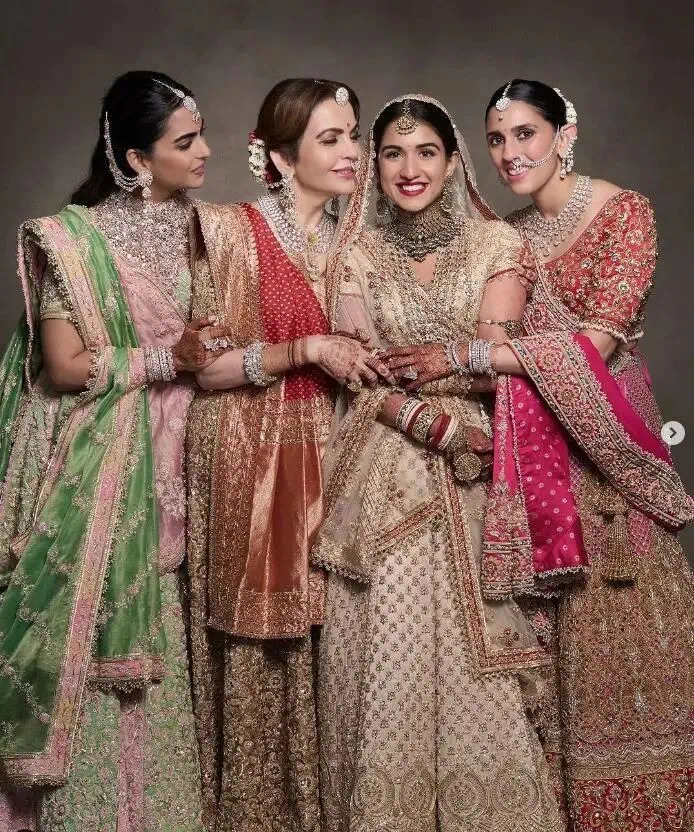
At previous pre-wedding parties, Nita Ambani, the billionaire’s wife, wore an emerald pendant larger than a vicks inhaler bottle, which was jaw-dropping.
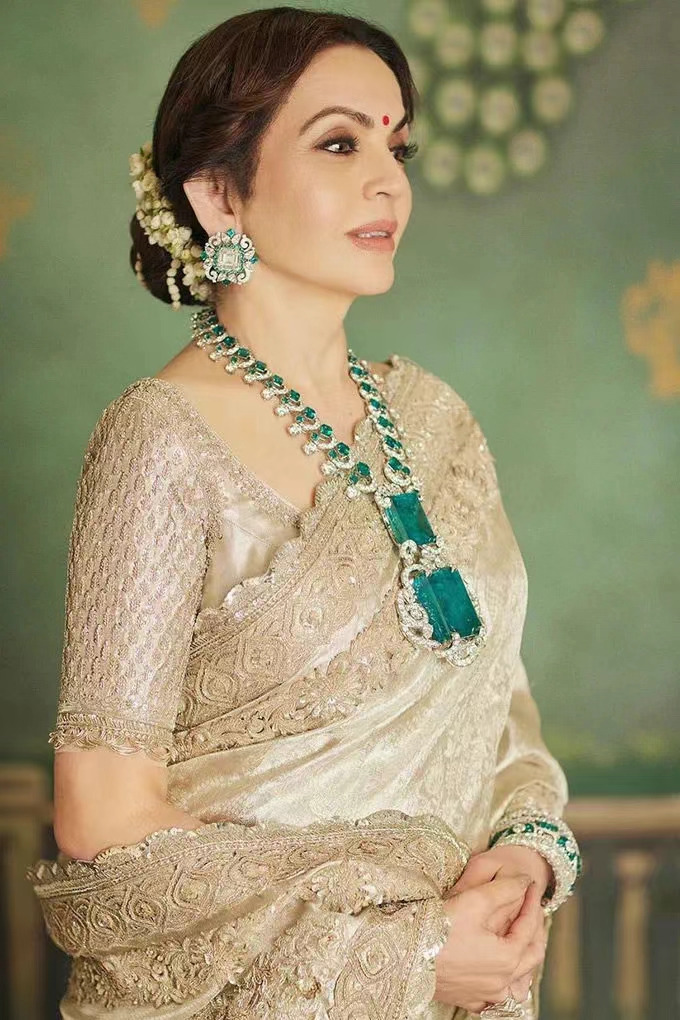
At the official wedding, Nita Ambani showcased even more “vicks inhaler series” jewelry, including a large carat emerald set and a super luxurious yellow diamond set with the main stone exceeding 100 carats.
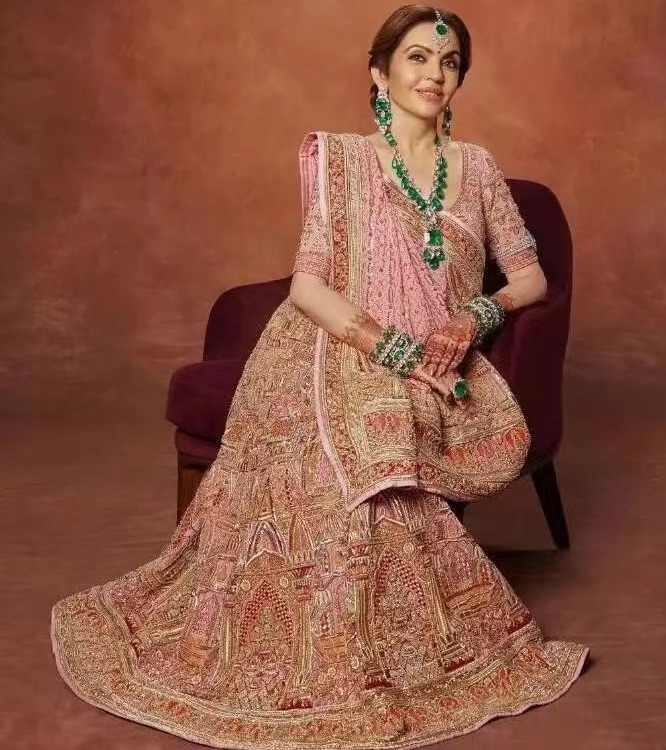

The bride, Radhika Merchant, was equally impressive in her jewelry choices. Her five-row diamond necklace with a “heart-protecting mirror” emerald pendant was a true family heirloom, rivaling her mother-in-law’s attire in luxury.
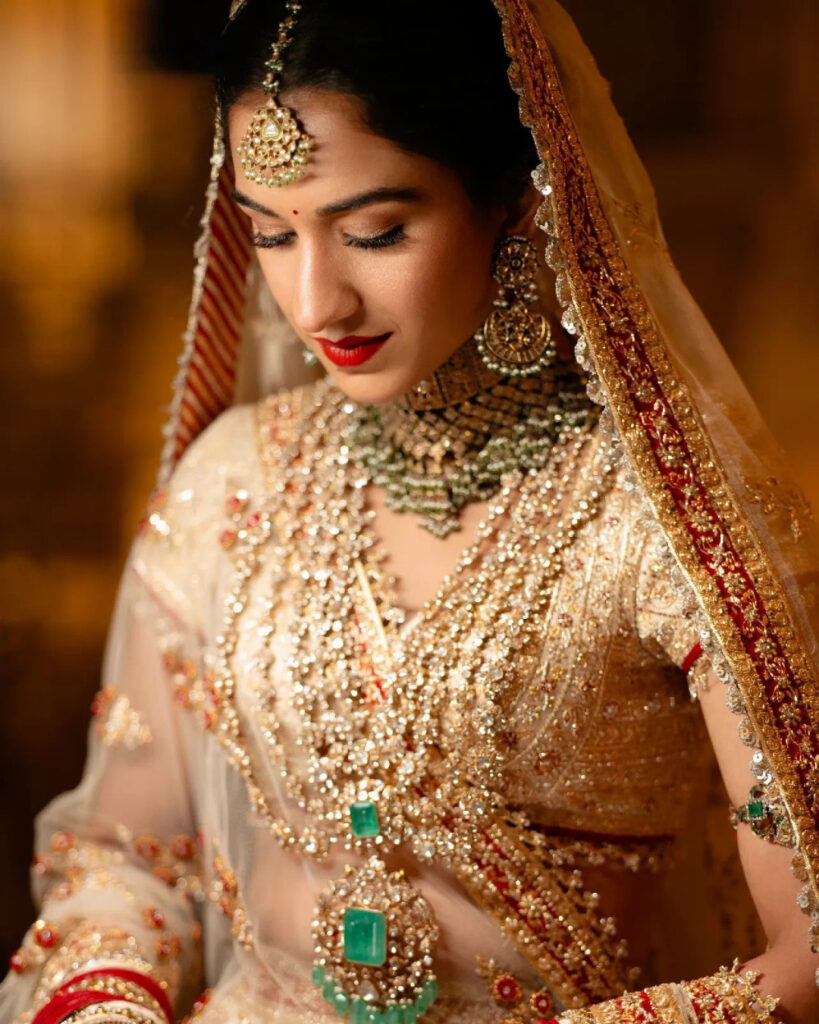
Another emerald set she wore was distinctly Indian in style, featuring a multi-layered emerald and diamond necklace with five pendants, complemented by matching earrings. The jewelry design was elegant, vintage, and exuded opulence.

She also wore a pink hand-painted Indian-style dress paired with a matching pearl, diamond, and emerald set, exuding sweetness and gentleness – a true noble “little princess”!
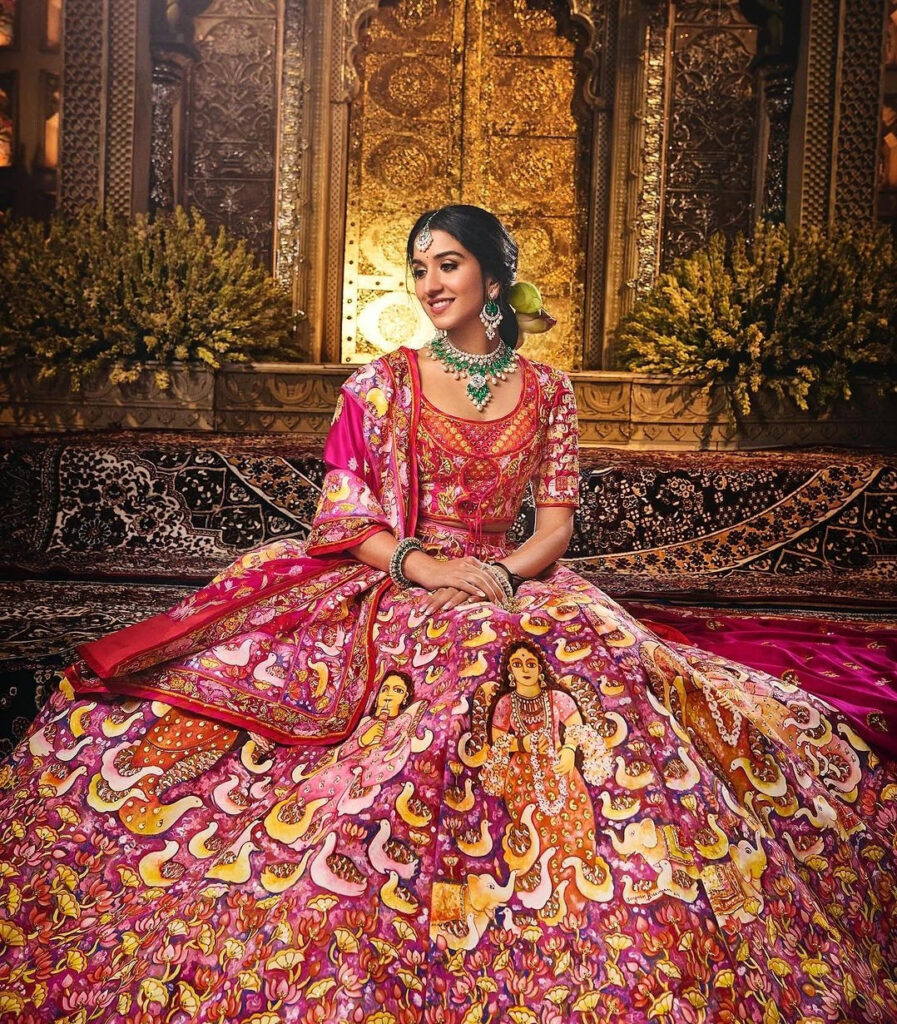
However, the most striking piece of jewelry at the event was the Navratna necklace worn by the billionaire’s daughter, Isha Ambani, which is considered a traditional Indian talisman.
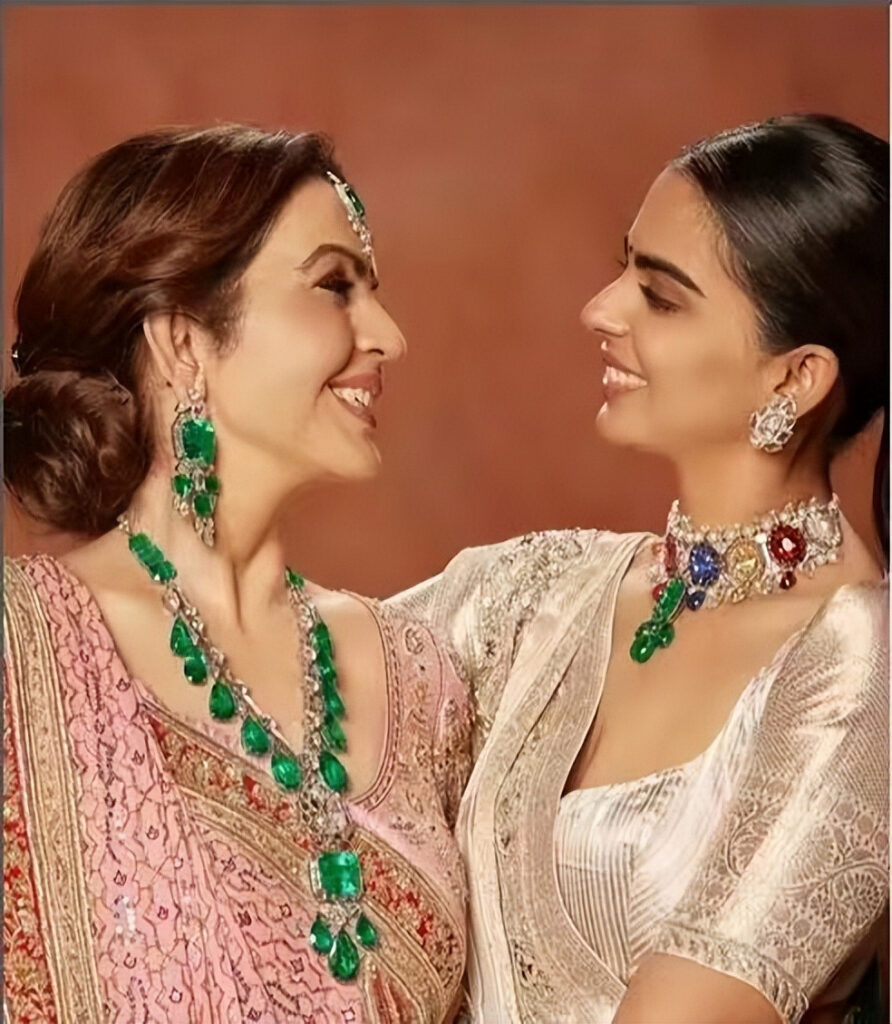
The necklace featured nine large gemstones, including ruby, emerald, sapphire, and cat’s eye, arranged in a row. The color and quality of these gems were undoubtedly top-tier. It’s said that Isha Ambani spent three years collecting these premium gemstones, making this piece extraordinarily significant to her.
So, what exactly is Navratna? And what symbolic meanings does it carry?
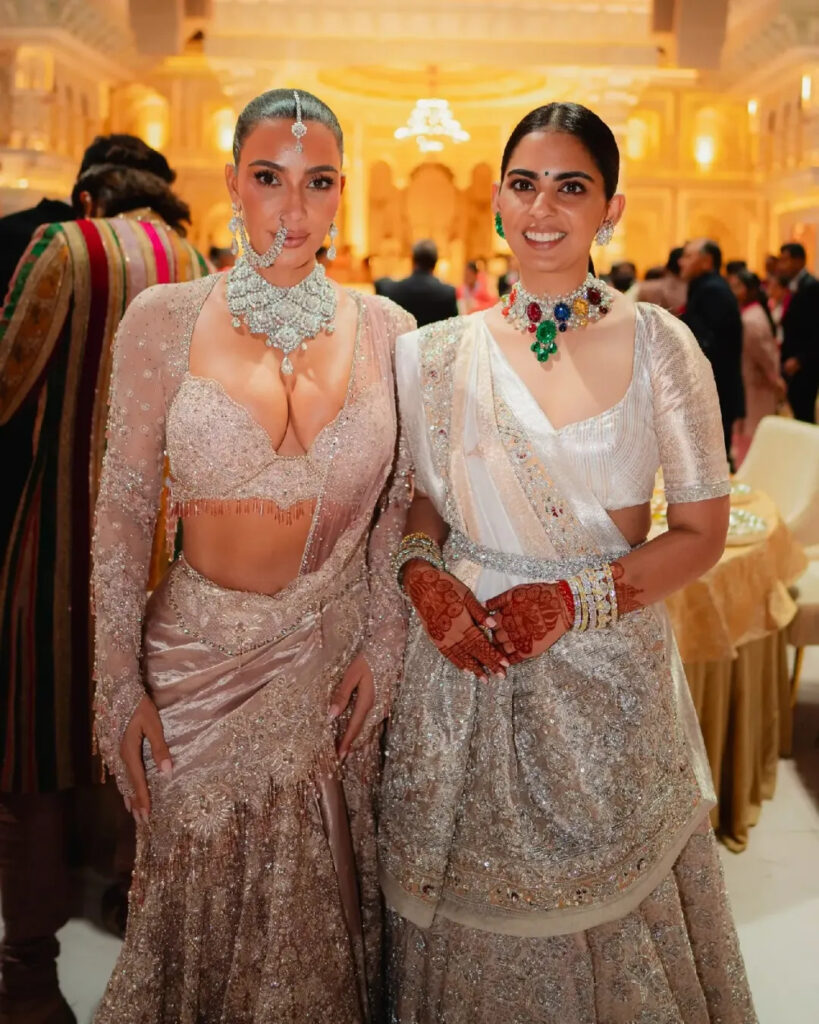
Navratna: A Talisman Jewelry Derived from Hindu Culture
If we were to name a country where people love wearing jewelry the most, India would undoubtedly be on the list.
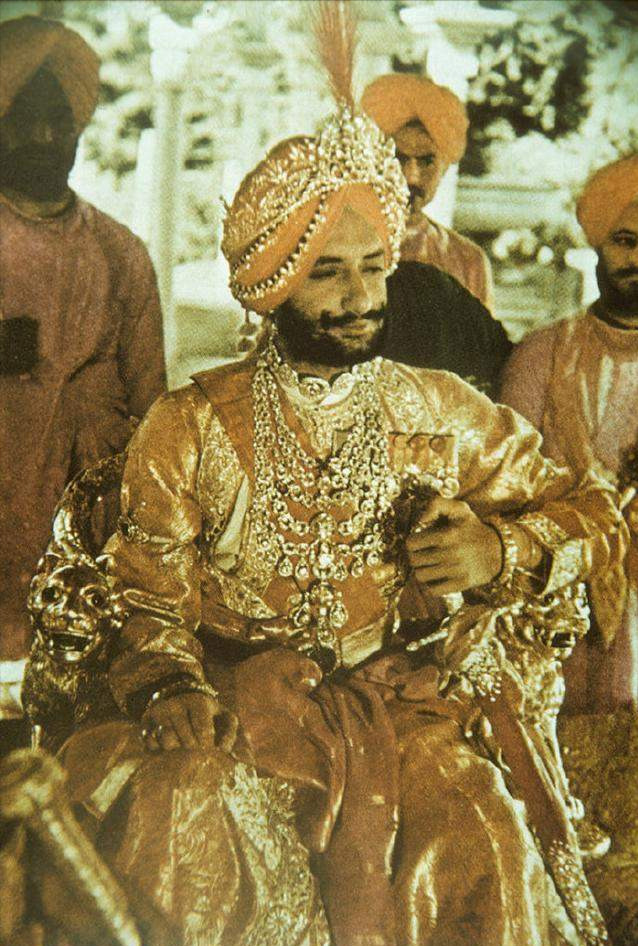
In people’s impressions, whether it’s high-ranking Indian rulers or low-status poor women, they all adorn themselves with sets of jewelry that jingle as they walk.

This fascination with jewelry appeared as early as 5,000 years ago during the Indus Valley Civilization.
In the early days, due to limited processing techniques, ancient Indians simply polished natural materials like shells, stones, and bones, stringing them together to wear as adornments.

As time passed, ancient Indians’ jewelry craftsmanship became increasingly sophisticated, and jewelry styles became more luxurious and diverse. This trend reached its peak during the Mughal Empire, when jewelry art and aesthetics achieved their zenith.
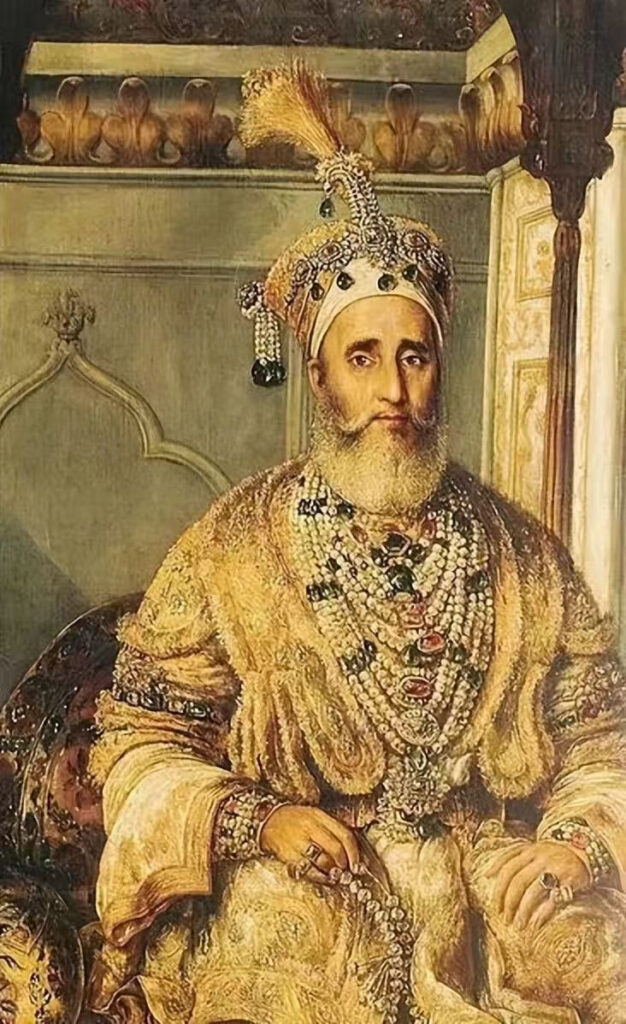
This obsession with jewelry is inseparable from India’s geographical location, the preferences of its rulers, and religious beliefs.
As is well known, India is a famous gemstone source in the world. Besides the world-renowned diamonds, it also produces beryl, sapphires, moonstones, almandine garnets, and chrysoberyls. The surrounding areas of Myanmar, Sri Lanka, and the Persian Gulf are among the world’s top producers of rubies, sapphires, and pearls.
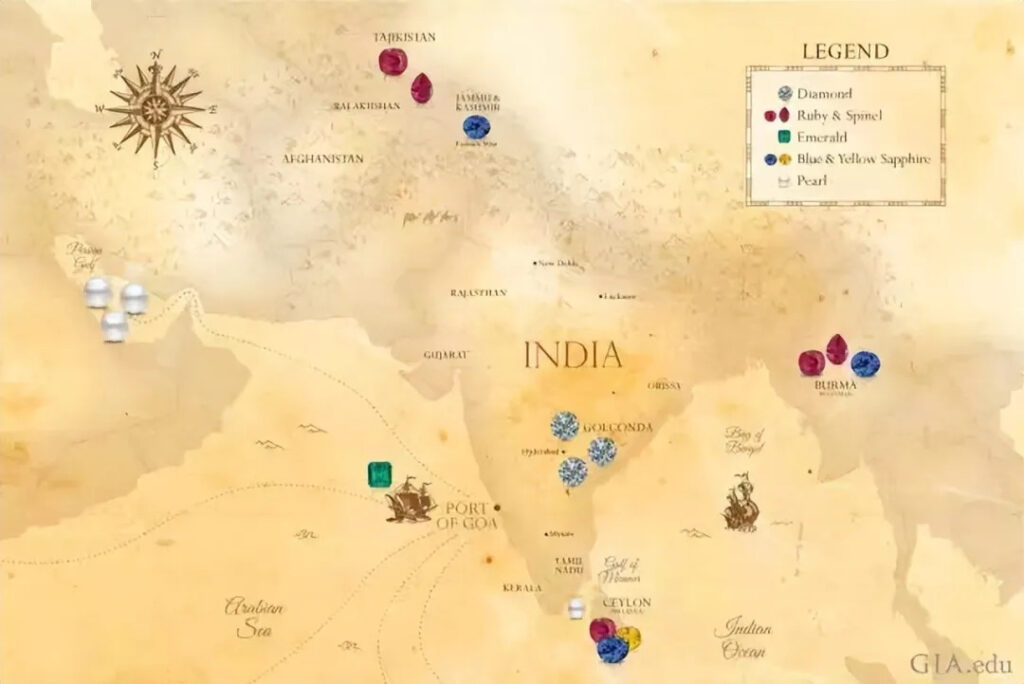
The Mughal Empire was India’s most important dynasty. From its ancestor Timur, there was a tradition of collecting precious gemstones like diamonds, emeralds, and spinels. The fifth Sultan, Shah Jahan, even used these rare and precious gemstones to build the Peacock Throne, symbolizing his supreme power and considered one of the greatest wonders of the 17th century.

During this period, jewelry was not just for decoration; it was more a symbol of the wearer’s identity, status, and wealth.

Apart from the influence of geographical location and the preferences of dynasty rulers, the strong religious culture also had a subtle impact on the development of Indian jewelry.
The Indian subcontinent is a place with a very strong religious atmosphere. This magical land has given birth to religions such as Hinduism, Buddhism, Sikhism, and Islam, with Hinduism and Buddhism having the most significant influence and widest spread.
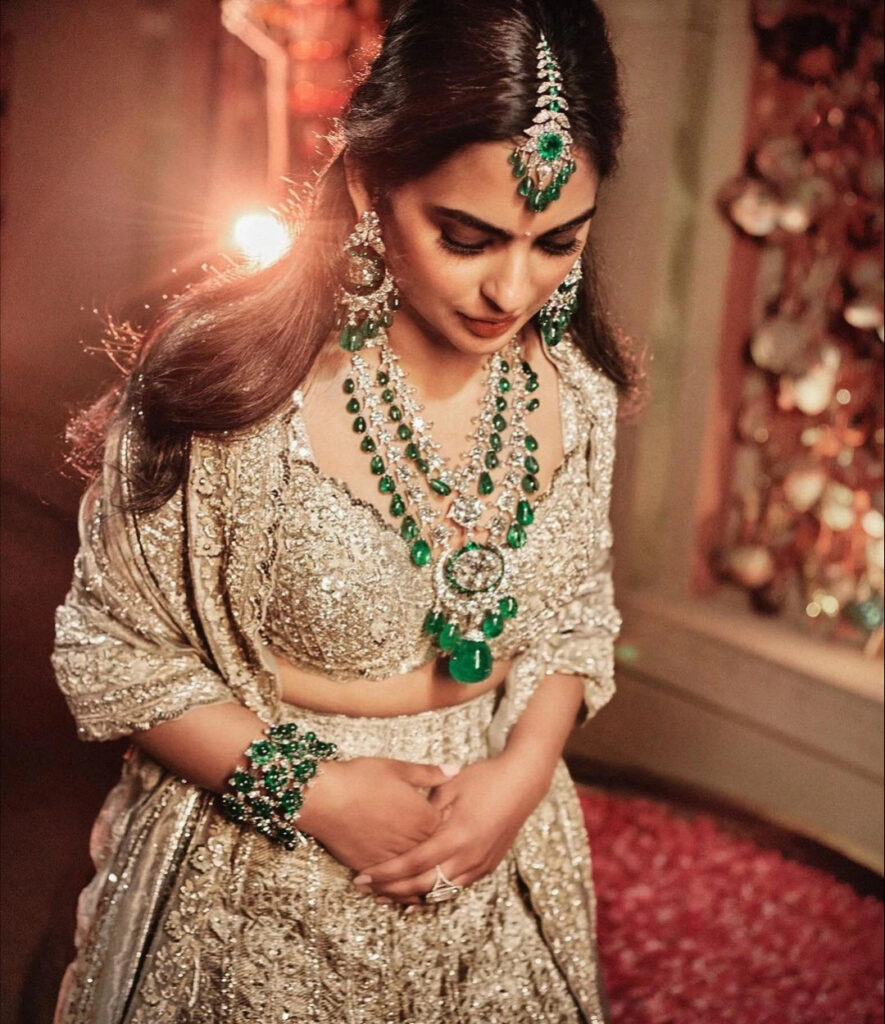
is a piece of jewelry born out of religious influence
In Hindu beliefs, precious metals like gold and silver, as well as gemstones, are given special meanings.
Silver symbolizes the cool moon, while gold represents the warm sun, embodying eternity and immortality. Gemstones represent celestial bodies in the universe and are seen as channels for communicating with deities, used for divination.
The Sanskrit classic on gemstone research, “Ratnapariksa” (Treatise on Gems), which appeared in the 5th century, further elaborates on the relationship between gemstones and deities, planets, and calendars.
According to the treatise, human life is influenced by seven celestial bodies – the Sun, Moon, Mercury, Jupiter, Venus, Mars, and Saturn – as well as the north and south lunar nodes. Each celestial body corresponds to a gemstone. By combining these gemstones representing celestial bodies in a certain order and wearing them, one can harness beneficial planets or counteract harmful ones, thus influencing people’s lives.
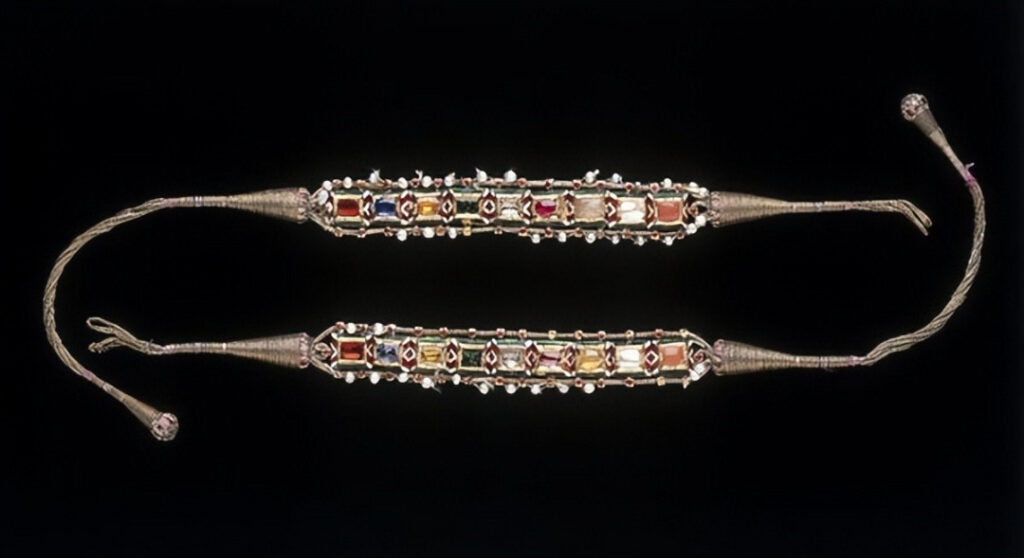
The Navratna jewelry, one of the most powerful talismans in Hinduism that we are introducing today, was born under the influence of this religious culture.
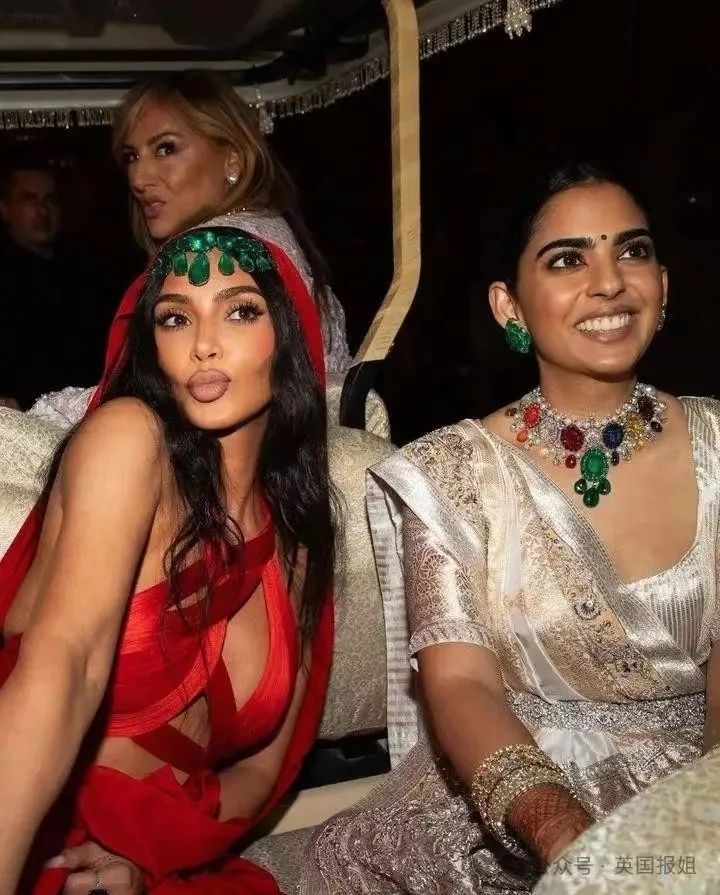
Navratna jewelry containing 9 types of gemstones
“Navratna” is a Sanskrit compound word that directly translates to “nine gems,” specifically referring to a jewelry style that incorporates nine types of gemstones.
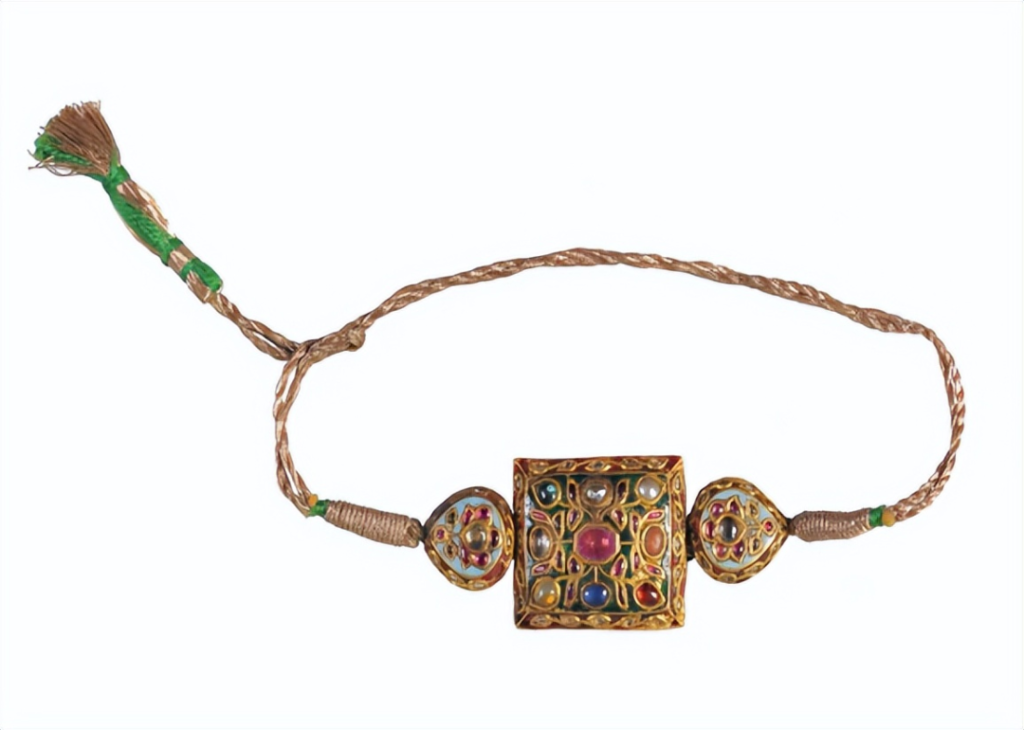
These nine gemstones are not arbitrarily chosen. They each represent celestial bodies in Hindu astrology:
- Ruby – Sun
- Pearl – Moon
- Emerald – Mercury
- Coral – Mars
- Yellow Sapphire – Jupiter
- Diamond – Venus
- Blue Sapphire – Saturn
- Zircon or Hessonite Garnet – Rahu (shadow planet)
- Cat’s Eye – Ketu (shadow planet)
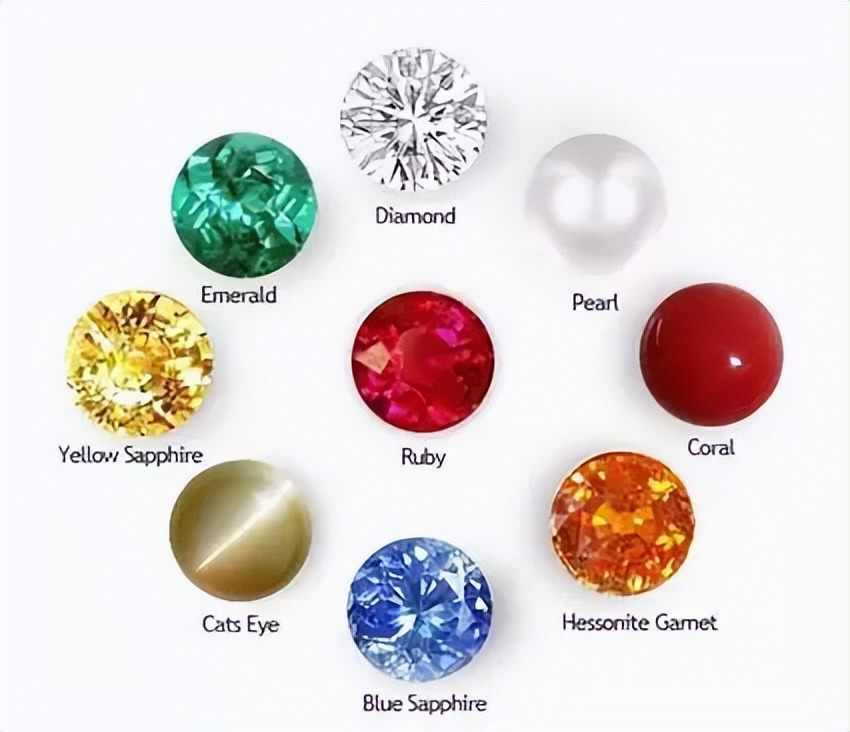
Ruby – The Sun
In Hindu culture, the sun god is called “Surya” and is one of the five deities worshipped by Indians.
Legend has it that Surya has golden skin, four arms, wears a crown, and rides seven warhorses. He is considered the creator of the universe and the source of all life, bringing light and warmth to the world.
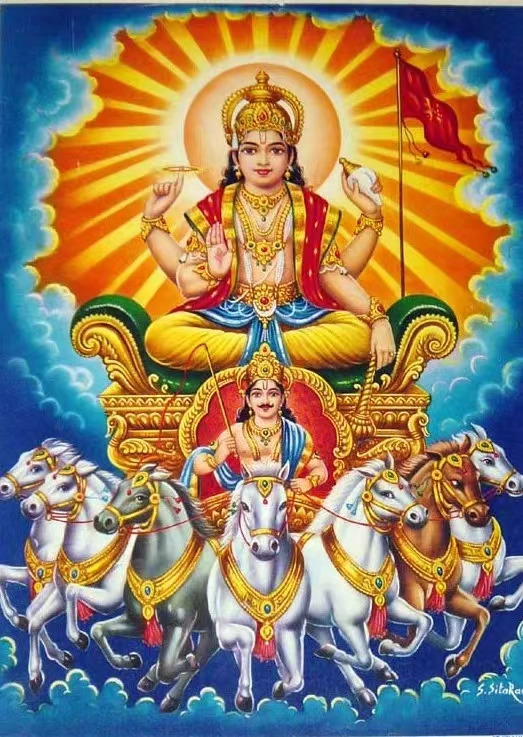
In Vedic astrology, ruby is used to enhance solar energy. Its vibrant color closely resembles the fiery sun, symbolizing power, life, and youthful vitality.
In Navratna jewelry, the ruby representing the sun is often placed at the center, symbolizing the center of the universe, surrounded by other gemstones. It is believed to improve people’s lives and bring success in career.
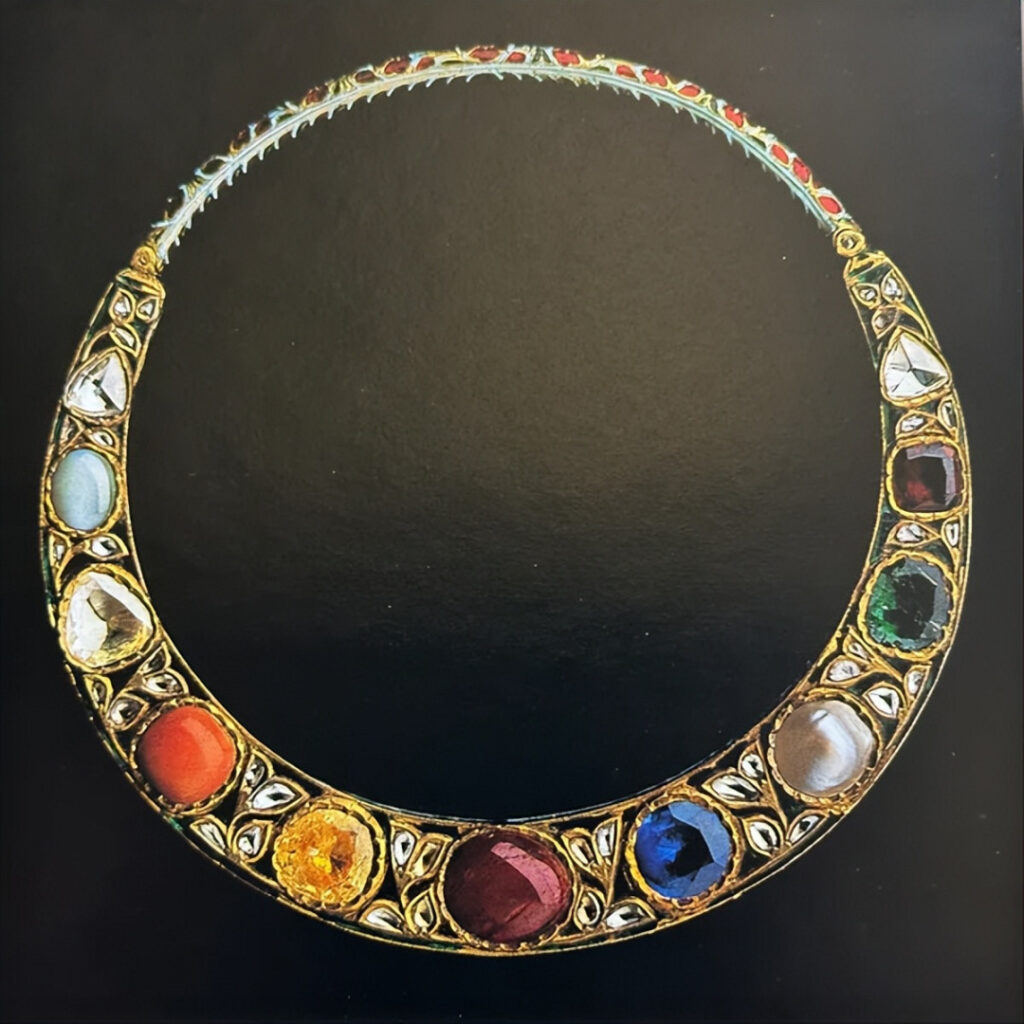
Pearl – The Moon
The moon, as a reflector of the sun’s radiance, carries yin energy, complementing the sun’s yang.
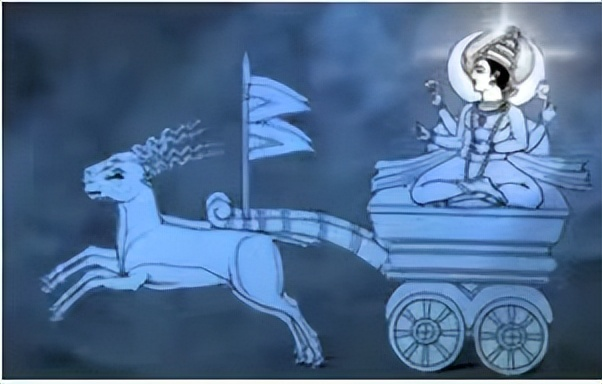
In Vedic astrology, the soft and gentle pearl is seen as a symbol of the moon. Particularly, top-quality pearls that are white, round, and lustrous are believed to not only enhance the moon’s influence but also bring emotional calm and stability.
However, pearls are not suitable for everyone. When wearing them, it’s best to achieve an energy balance with other gemstones. Otherwise, it may lead to anxiety, mood swings, and isolation.
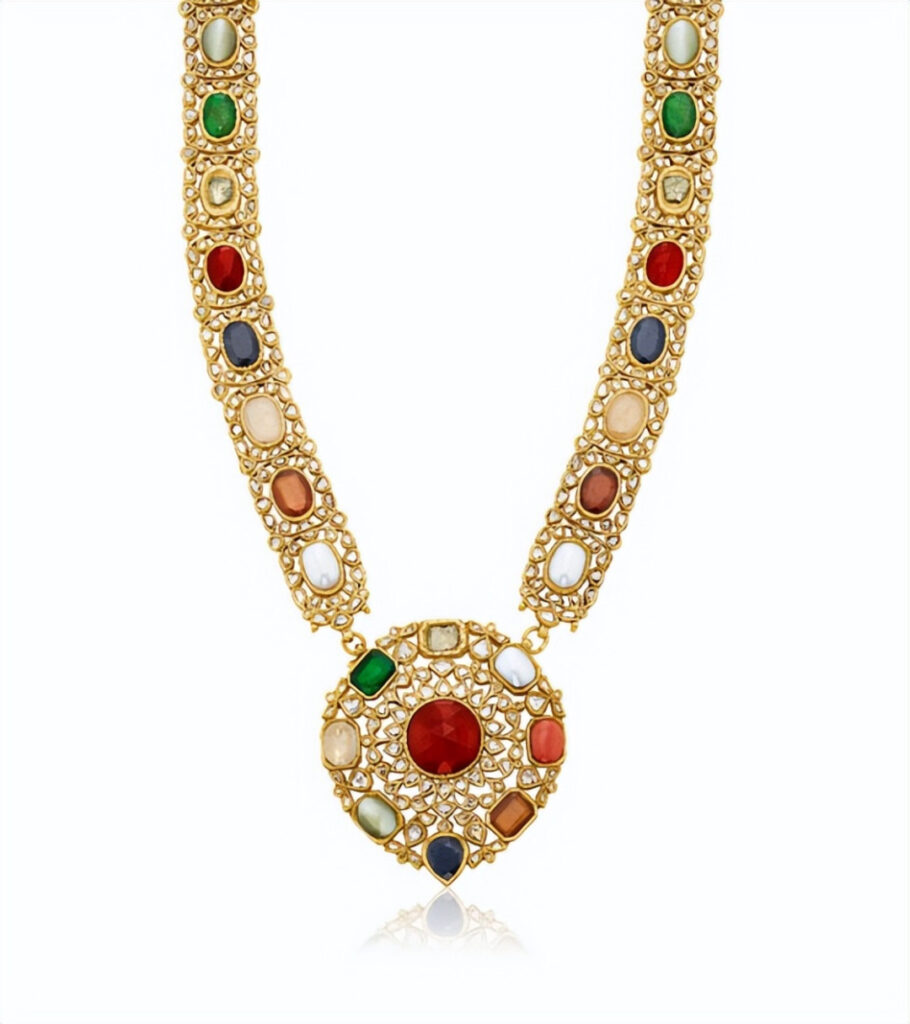
Emerald – Mercury
Mercury is the planet closest to the sun in our solar system. In Indian mythology, Mercury (Budha) is the illegitimate child of the moon god and Jupiter’s wife, Tara. He is the god of wisdom and communication.
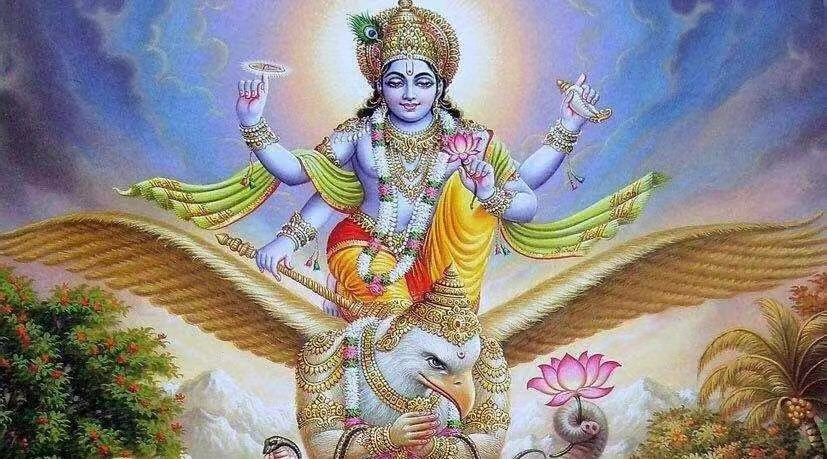
In Vedic astrology, emerald is considered synonymous with Mercury.
At that time, emerald was seen as a symbol of immortality. Indians deified emerald, believing it could ward off evil and possessed extremely powerful energy.
In India, both commoners and royalty took pride in owning emeralds. Nobles, in particular, collected many large emeralds, believing they could make the wearer happy (who wouldn’t be happy wearing large emerald gemstones?).
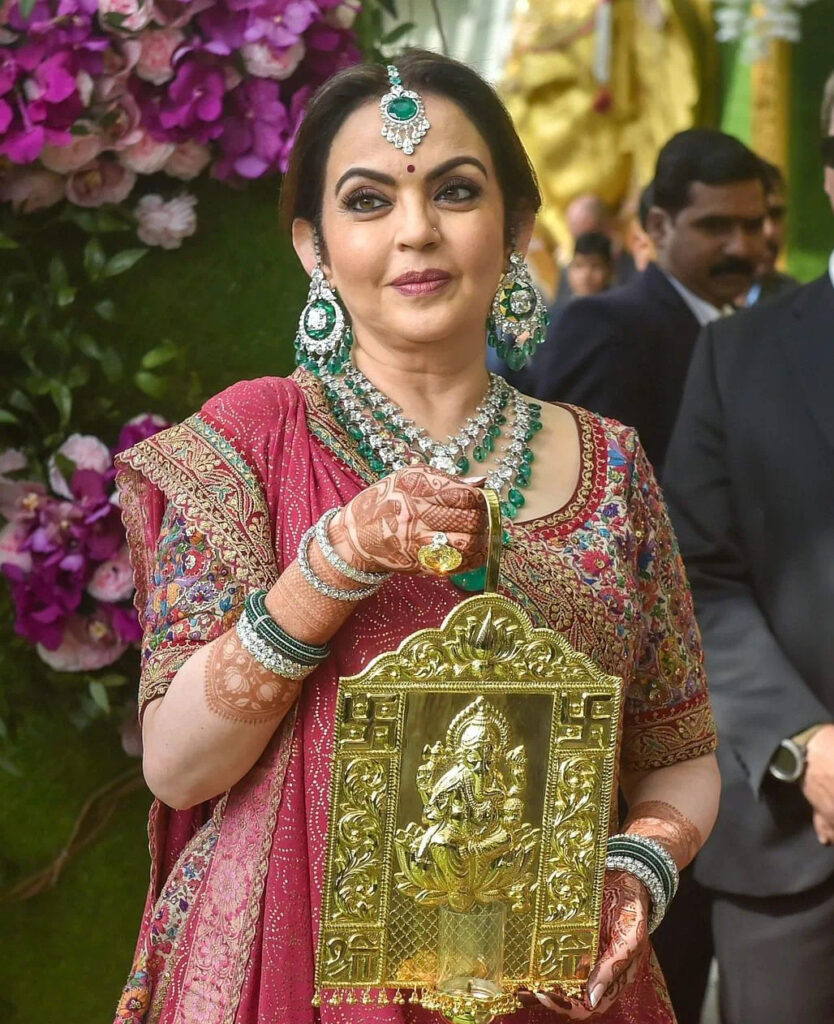
For this reason, the highly esteemed emerald, representing royalty and divinity, became associated with Mercury. Wearing it is believed to enhance the wearer’s intelligence, communication skills, and memory, promoting harmonious interpersonal relationships.

Coral – Mars
Mars is the planet between Earth and Jupiter in the solar system, symbolizing energy, decisiveness, courage, and fighting spirit.
In Vedic astrology, vibrant red coral is used to symbolize Mars. It is believed to enhance the wearer’s vitality, bringing energy, strength, and passion.
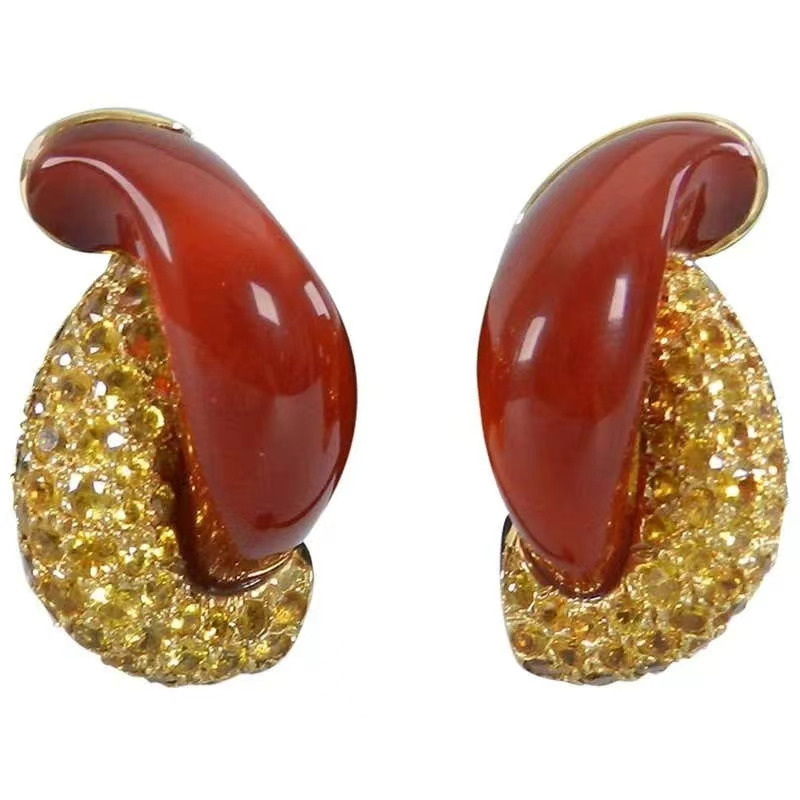
However, wearing red coral may have some side effects, potentially causing over-excitement and difficulty in controlling one’s temper.

Yellow Sapphire – Jupiter
Jupiter is the largest planet in the solar system and is considered the first auspicious star. It represents wisdom, judgment, enthusiasm, and happiness.
Yellow sapphire is viewed as the symbol of Jupiter and is believed to bring abundance, wisdom, and good fortune. Especially when Jupiter is weak in one’s personal astrological chart, wearing yellow sapphire can fill life with joy and beauty.
Diamond – Venus
Venus is located between Mercury and Earth in the solar system, representing purity, beauty, and love.
In Vedic astrology, the hard and pure diamond is often associated with Venus. Wearing a diamond is believed to control Venus’s energy, promoting harmony in life and bringing wealth and love to people.
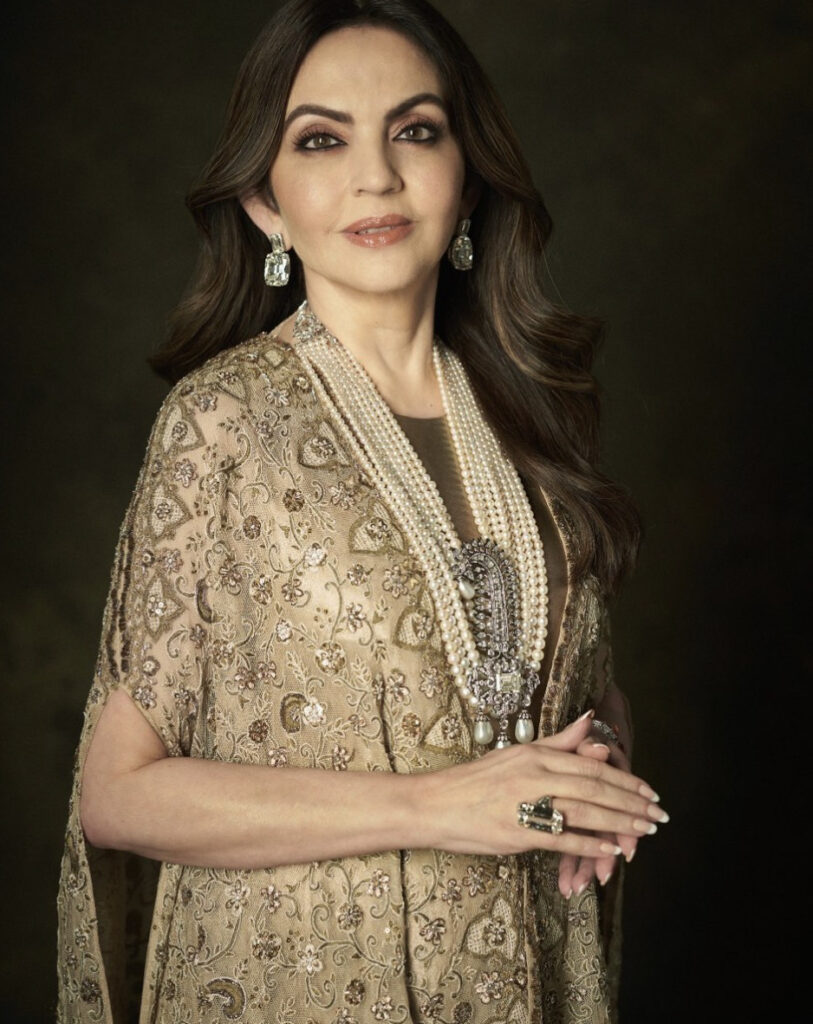
Blue Sapphire – Saturn
Saturn is the planet between Jupiter and Uranus in the solar system. It represents responsibility, discipline, and endurance, and is considered the source of all limitations and constraints. A weak Saturn is believed to bring disease, insomnia, and financial problems to people.
In Vedic astrology, blue sapphire, revered as a source of wisdom, prophecy, and power, symbolizes Saturn. Wearing it is believed to help overcome obstacles and challenges in life, promoting wisdom and spiritual awakening.
However, not all blue sapphires have such effects. The efficacy depends on the size, purity, flaws, and compatibility with other gemstones. Improper wearing may bring trouble to the wearer.
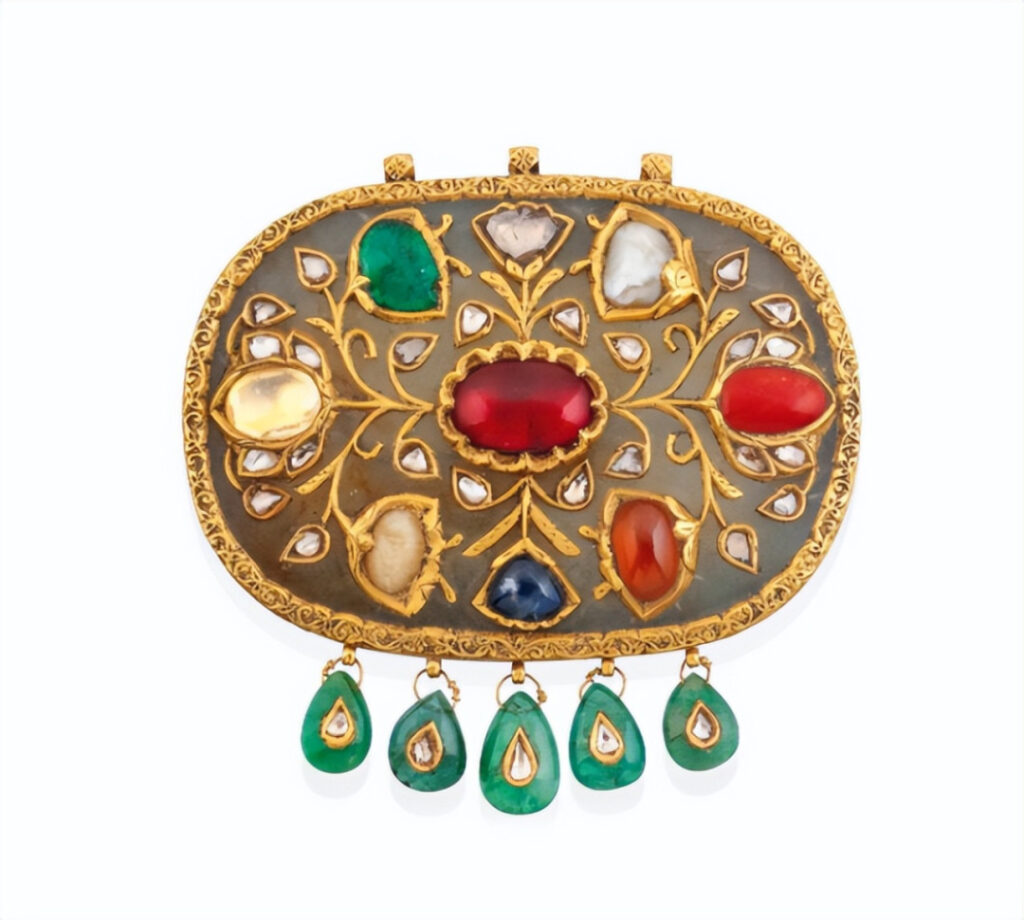
Garnet – Rahu (Shadow Planet)
Unlike the seven planets mentioned above, Rahu and Ketu are not real planets.
They are two virtual points in the sky, representing the intersections of the moon’s orbit around Earth and Earth’s orbit around the sun. Thus, they are also known as the moon’s nodes.
Rahu is the north node, representing illusion, desire, and the pursuit of the material world.
In Vedic astrology, garnet is believed to control Rahu’s energy. Wearing it is thought to attract power and fame, and enhance people’s insight and awareness.
Cat’s Eye – Ketu (Shadow Planet)
Ketu is the south node, representing doubt, renunciation, uncertainty, and lack of insight. It is considered the source of all spiritual awakening and enlightenment.
In Vedic astrology, cat’s eye represents Ketu. Wearing it is believed to eliminate Ketu’s influence and alleviate the aforementioned issues.
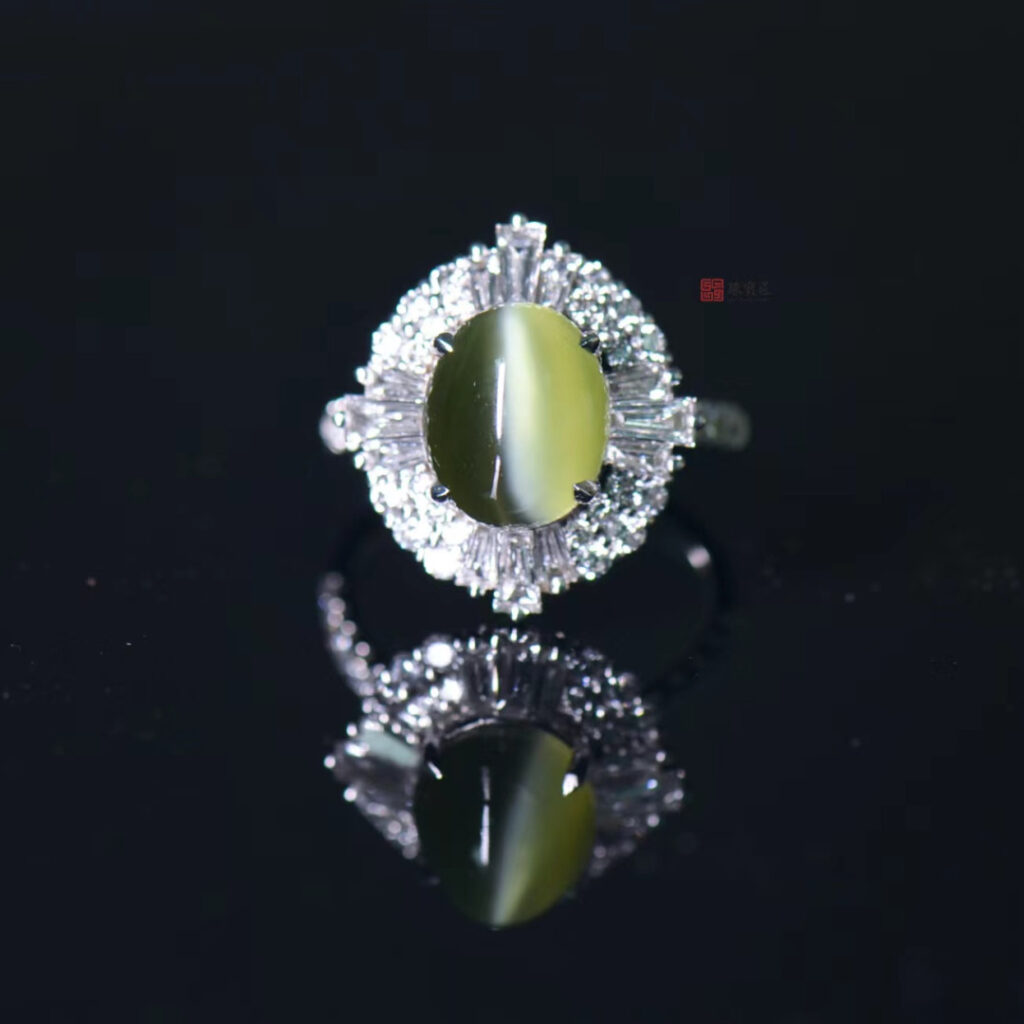
These nine gemstones symbolize the balance and equilibrium of the universe. Each stone is imbued with a sacred meaning. Arranging them in order according to one’s personal astrological chart is believed to balance the energies between the major celestial bodies, bringing good luck and health to the wearer.
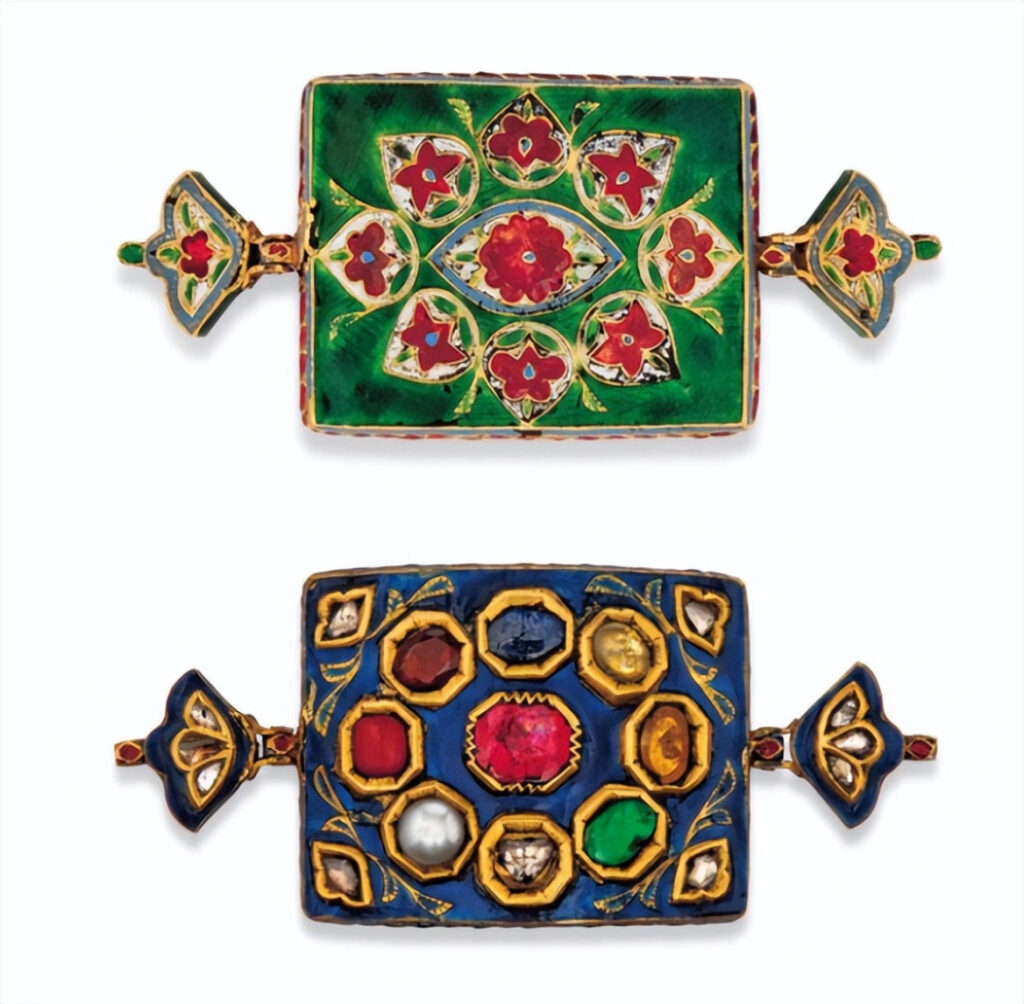
Amulets with Strong Indian Style
Navratna jewelry comes in various forms, including rings, earrings, pendants, necklaces, and bracelets. Different types of jewelry have different gemstone arrangements, commonly seen in square, circular, or octagonal shapes.

Regardless of the arrangement, the ruby symbolizing the sun is always at the center and is larger in size. The remaining eight gemstones of equal size are arranged in a specific order to harmonize cosmic forces in one’s personal astrological chart and maintain balance.

Not all qualities of gemstones are suitable for making Navratna jewelry.
From ancient Indian Navratna jewelry, we can see that these gemstones are usually flawless on the surface, with rich and pure colors, and fine, lustrous textures. They are the “stars” of each category.
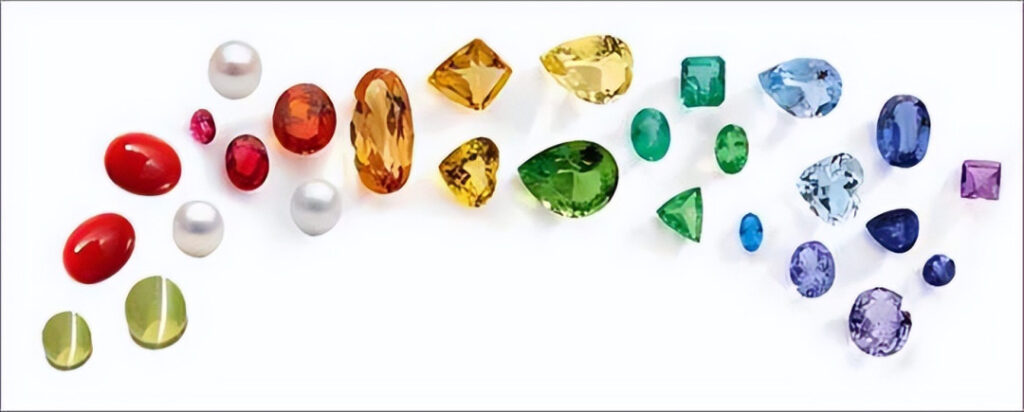
These high-quality gemstones maintain a natural, irregular beauty from the moment they are excavated. They are decorated using India’s unique metalworking technique: Kundan, which presents the most perfect side of the gemstones.
Kundan: An ancient Indian metalworking technique where artisans set diamond, gemstone, and pearl slices into slightly melted 24K gold bases, allowing the gems to be embossed on the metal surface of the ornament. Compared to European prong setting techniques, this method can more fully present exquisite gemstone totems.

In the early days, due to the extremely high quality requirements for gemstones in Navratna jewelry, the price was beyond what ordinary people could afford. Therefore, Navratna became an exclusive amulet for Indian royalty, with only Indian princes, viewed as incarnations of gods, having the qualification and means to wear them.
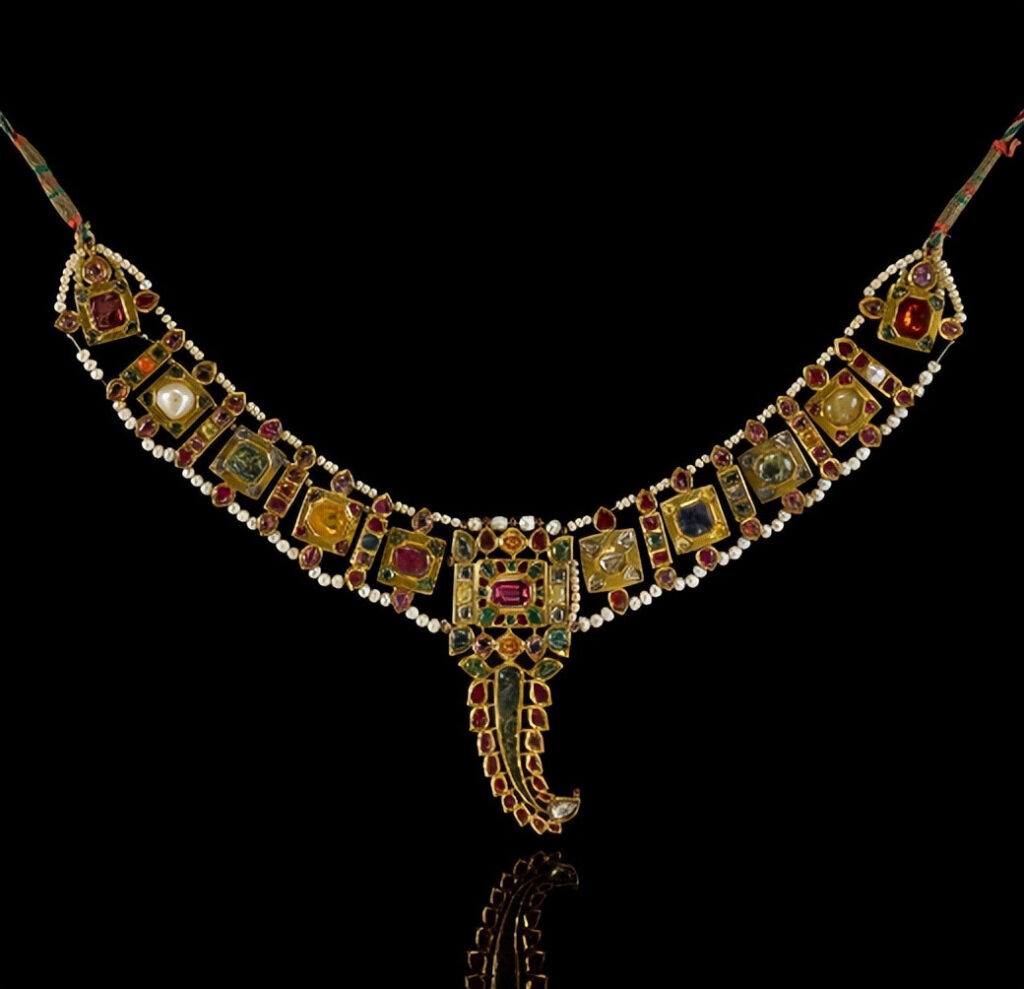
However, as Hindu astrology spread worldwide, more and more national leaders began to accept this concept of celestial energy. This Navratna jewelry, believed to possess powerful divine force, began to spread to countries like Thailand, Singapore, and Sri Lanka.
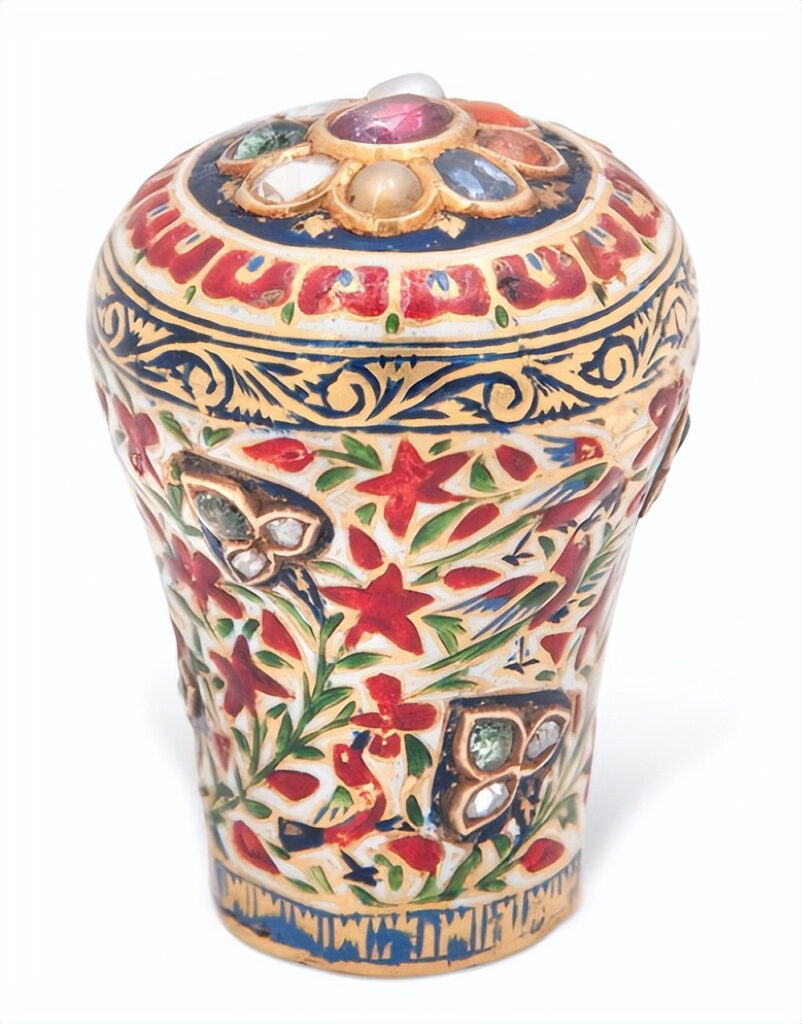
The requirements for wearers have gradually relaxed, spreading from rulers to the nobility and wealthy classes. Today, Navratna jewelry has become an amulet with strong Indian style, carrying people’s expectations and aspirations for a better life.
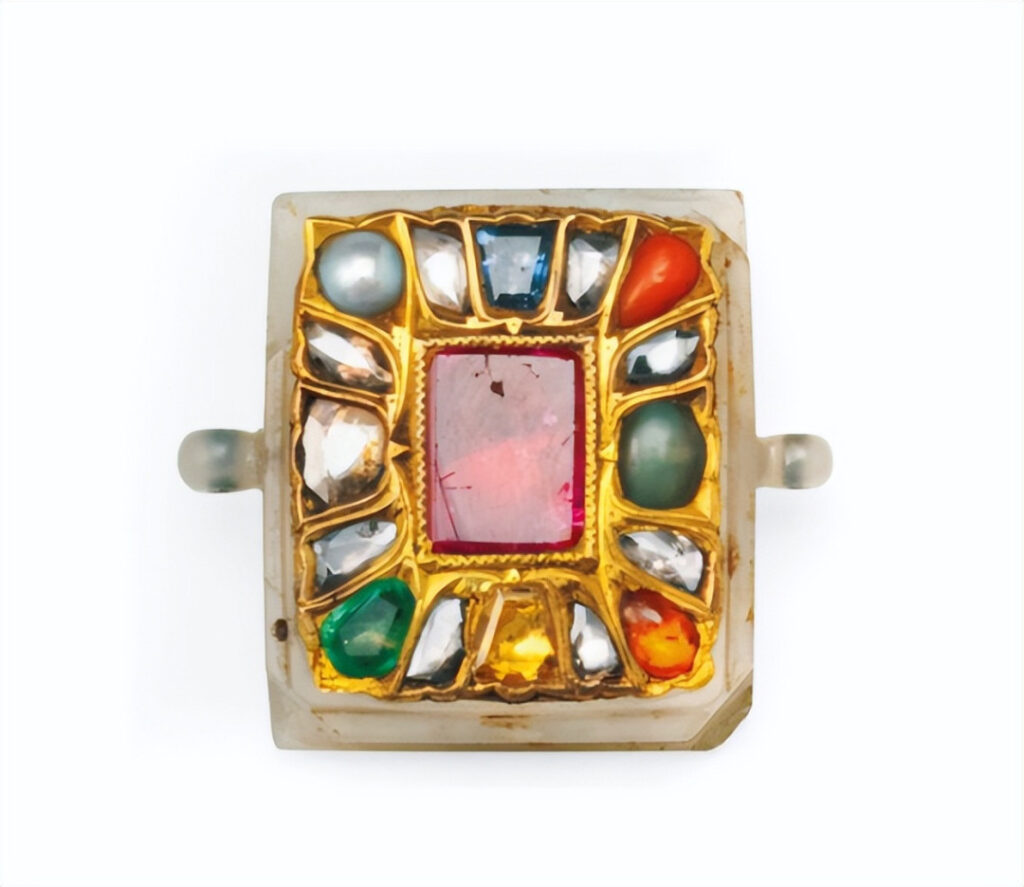
The editor has introduced many amulet jewelry pieces from various countries in previous articles, but India’s Navratna jewelry is undoubtedly the most distinctive. It is not only a microcosm of Indian religion and beliefs but also integrates astrological concepts, connecting individuals with the universe and reflecting a grand cosmic view.
On one hand, it can be a symbol of wealth and status; on the other hand, it can bring health and good fortune. Do you like this colorful Navratna jewelry with amulet significance? Feel free to share your thoughts in the comments!
The Ultimate Indian Talisman: Navratna – So Powerful Even Billionaires’ Daughters Save for Years to Own It!
Tweet





